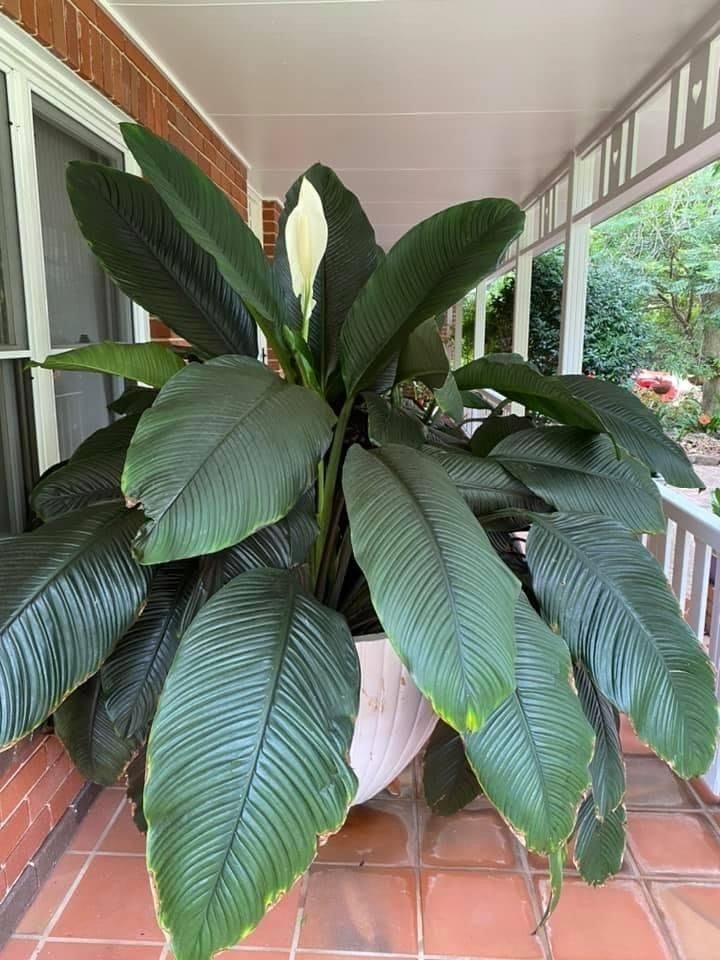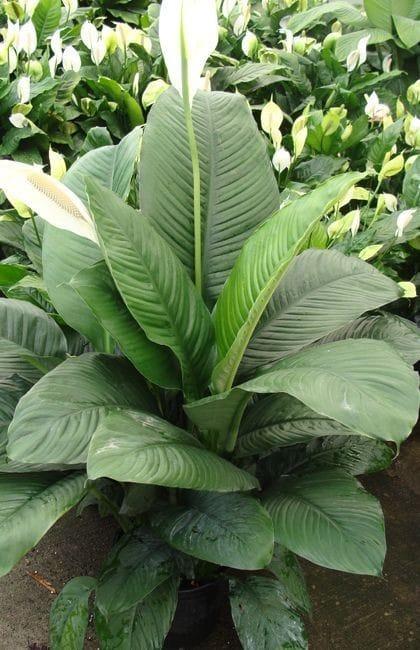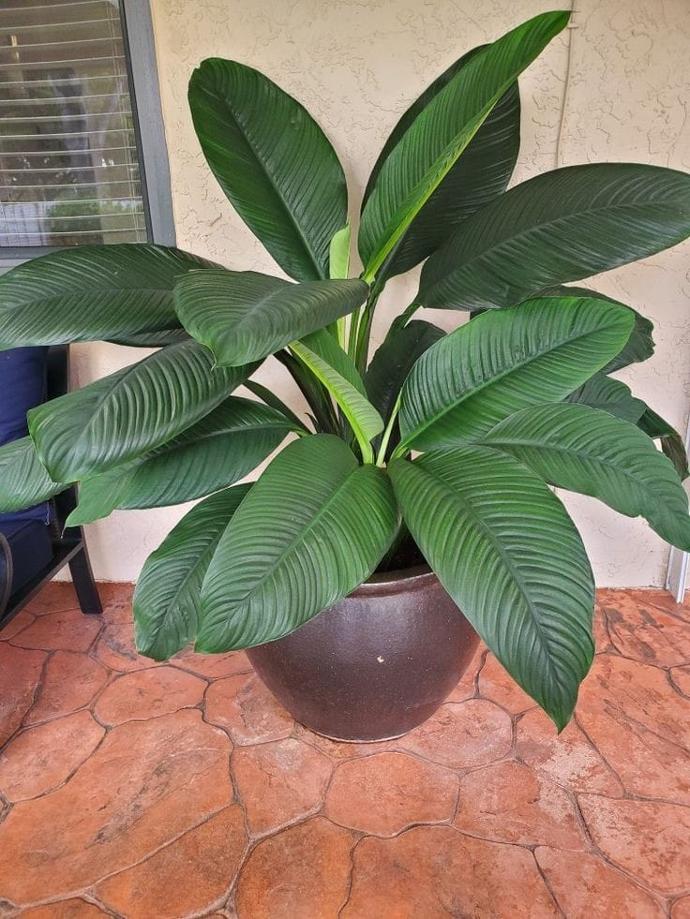Spathiphyllum Sensation Plant
Spathiphyllum Sensation, also known as Peace Lily, is an indoor plant with glossy green leaves and white flowers. Plant in well-draining soil and provide bright, indirect light. Keep the soil consistently moist. Pruning can be done to remove old or yellowing leaves and spent flowers.
Habit
Herbaceous
Height
0.9-1.5 m
Growth
Moderate
Soil
Well-drained, loamy
Shade
Low to bright indirect light
Moisture
Moist
Edible
No
Medicinal
Yes
Origin
Central America
Climatic Condition
Tropical, Subtropical
Temperature (°)
18-30°C
Humidity (%)
60-80%
Potting media
Peat, perlite
Fertilizers
Balanced, organic NPK
Watering
Regular
Plant Weight
100-200 g
Flowering Time
Summer
Soil Ph level
6.0 - 7.0
Water Ph level
6.0 - 7.0
Soil EC
1-2 dS/m
Yield Per Plant
Ornamental
NPK ratio
10:10:10
life Span
Perennial
Health Benefits
Air-purifying, ornamental
Suggested Grow Media or Potting Mix ?
50% peat, 25% perlite, 25% compost
Suggested Fertigation/Fertilizers
Fertilize every 2-3 weeks with a balanced fertilizer.
Common Diseases and Remedies
phytophthora root rot
Purpling and reddening of older leaves is a symptom of Phytophthora root rot.
Heavily infected plants should be discarded .
HEALTH BENEFITS
· Improves air quality by removing pollutants like benzene and ammonia.
· Has a calming effect on indoor environments.
What Is An Spathiphyllum ?
Spathiphyllum, commonly known as the peace lily, is a flowering plant native to the tropical regions of the Americas and Southeast Asia. They are the most popular gift houseplants due to their beautiful leaves and beautiful white flowers. Peace lilies are known for their ability to thrive in low light, making them a great choice for work and home. They are also known for their air purifying properties as they can help remove toxins from indoor air. Peace lilies require low maintenance and can be grown successfully by both beginners and experienced gardeners.

What Are The Different Types Of Spathiphyllum Plants?
1. Spathiphyllum wallisii:
Also known as peace lily, it is one of the most common plant species. It has shiny dark green leaves and white spots around the inflorescences.
2. Spathiphyllum cochlearispathum:
This species is found in Central and South America. It has narrower leaves and heavier flowers than S. wallisii.
3. Spathiphyllum floribundum:
This species, native to Colombia and Venezuela, has large, lance-shaped leaves and white flowers.
4. Spathiphyllum cannifolium:
Found in Central and South America, this species has long, narrow leaves that resemble some cannas. Like other Spathiphyllum, it produces white flowers.
5. Spathiphyllum patiinii:
This species is native to Ecuador and has lance-shaped leaves with a prominent midrib. Like other peace lilies, it has white flowers.

1. Location
Urban gardeners who compromise with planting magnificent and stunning plant buddies in their homes due to lack of space get happy with the mention of this areca palm variety. It requires propagation in small and colorful plastic pots with well-draining soil, and it will remain lowkey throughout its growth journey. These thrive better in a partially shaded spot safe from wind.
2. Dypsis Decaryi
Often called the triangle palm, it gets its name from its triangular appearance. One can trace this palm’s lineage back to Madagascar, where it was found flourishing with enchanting beauty. Unlike the standard variety, this palm grows old with a single trunk from which branches triangular foliage shaded green to blue.
3. Dypsis Utilis
If you are looking for an evergreen areca palm, your search must end here. This variety is known for its bushy foliage that results from multiple stems gathering several leaflets. The areca palm leaf is not only large, but it is also super gorgeous. This variety also finds significance in medical books due to its health benefits.
4. Dypsis Lanceolata
One of the lesser-known species of indoor palm plants, this species is mainly known for its decorative value in warm and tropical regions. The plant originated in the surreal lands of the Comoro Islands, only to be spread around the tropical and subtropical areas worldwide. This variety can always be noticed when planted in the home gardens!
5. Dypsis Prestoniana
One of the largest varieties of indoor palm trees, this is a perfect palm plant indoors in one’s ornamental garden. It soon becomes the highlight of any place due to its gigantic and bright foliage. Originally from Madagascar, the plant loves the heat of the tropical climates with more humidity than dryness. One may grow it in large ceramic pots to accommodate the beauty that it is!

FAQs About Growing Areca Palms
1. Dypsis Baronii
Urban gardeners who compromise with planting magnificent and stunning plant buddies in their homes due to lack of space get happy with the mention of this areca palm variety. It requires propagation in small and colorful plastic pots with well-draining soil, and it will remain lowkey throughout its growth journey. These thrive better in a partially shaded spot safe from wind.
2. Dypsis Decaryi
Often called the triangle palm, it gets its name from its triangular appearance. One can trace this palm’s lineage back to Madagascar, where it was found flourishing with enchanting beauty. Unlike the standard variety, this palm grows old with a single trunk from which branches triangular foliage shaded green to blue.
3. Dypsis Utilis
If you are looking for an evergreen areca palm, your search must end here. This variety is known for its bushy foliage that results from multiple stems gathering several leaflets. The areca palm leaf is not only large, but it is also super gorgeous. This variety also finds significance in medical books due to its health benefits.
4. Dypsis Lanceolata
One of the lesser-known species of indoor palm plants, this species is mainly known for its decorative value in warm and tropical regions. The plant originated in the surreal lands of the Comoro Islands, only to be spread around the tropical and subtropical areas worldwide. This variety can always be noticed when planted in the home gardens!
5. Dypsis Prestoniana
One of the largest varieties of indoor palm trees, this is a perfect palm plant indoors in one’s ornamental garden. It soon becomes the highlight of any place due to its gigantic and bright foliage. Originally from Madagascar, the plant loves the heat of the tropical climates with more humidity than dryness. One may grow it in large ceramic pots to accommodate the beauty that it is!
